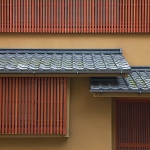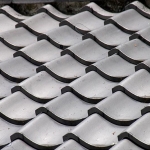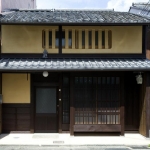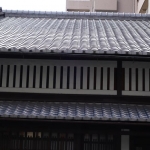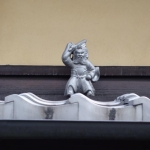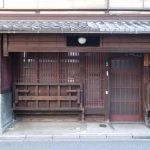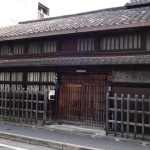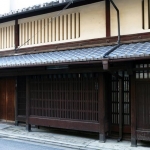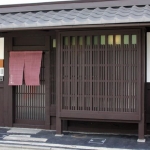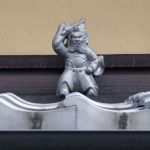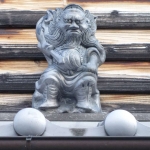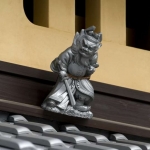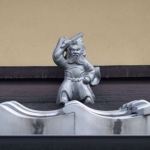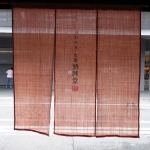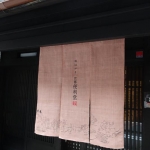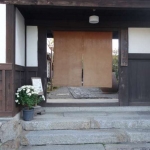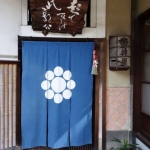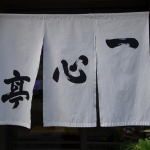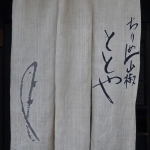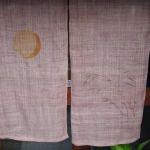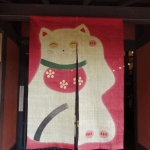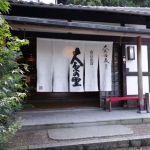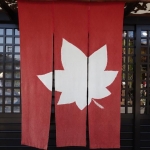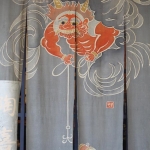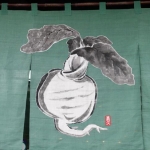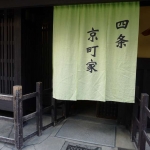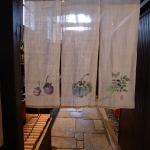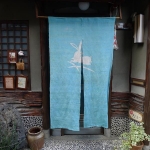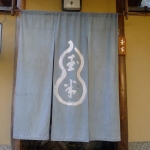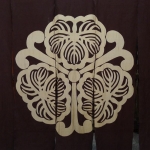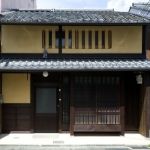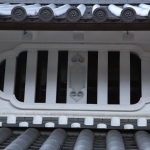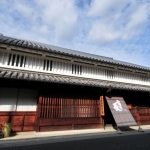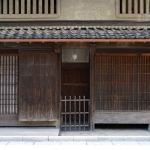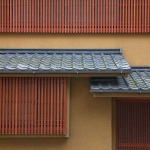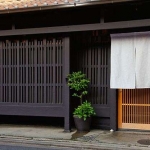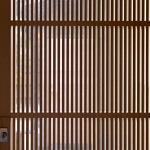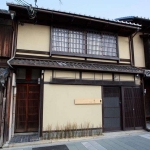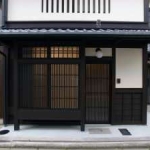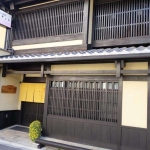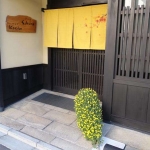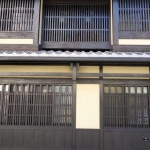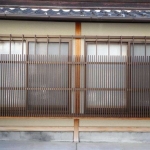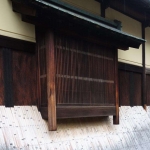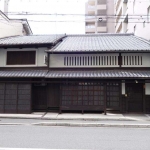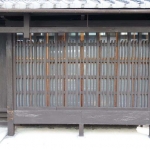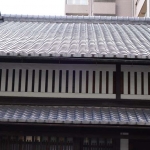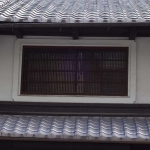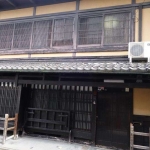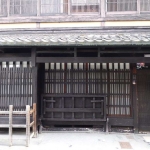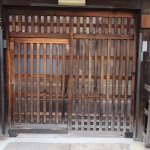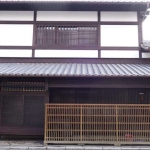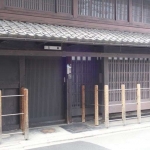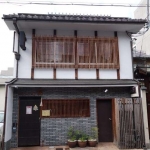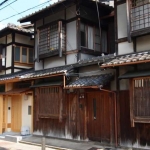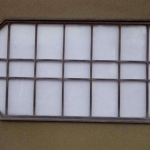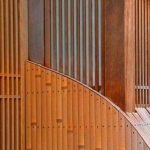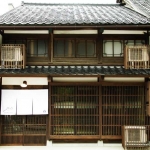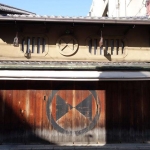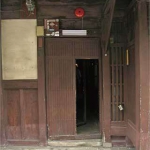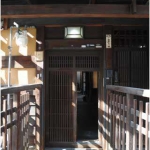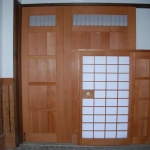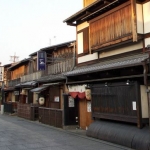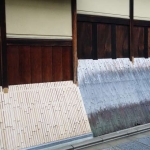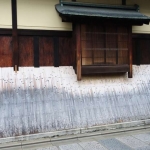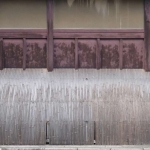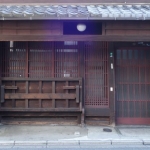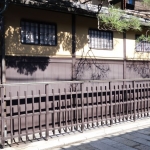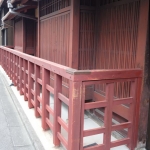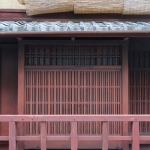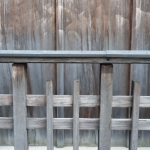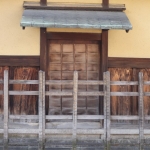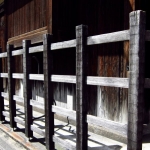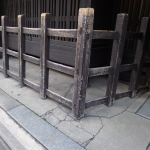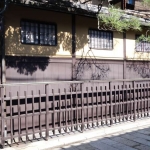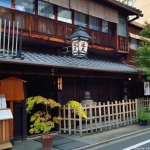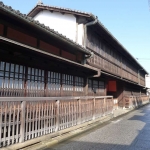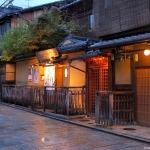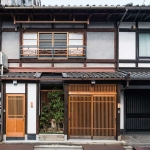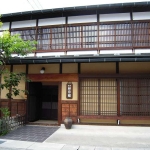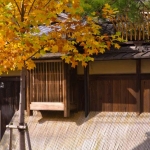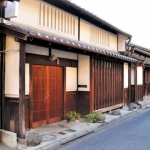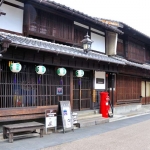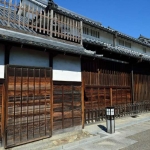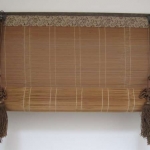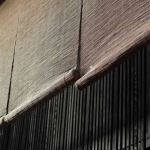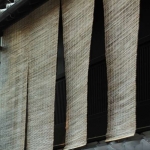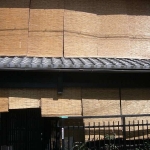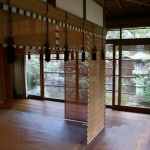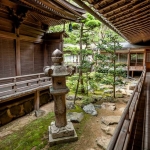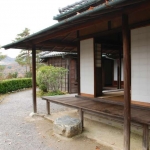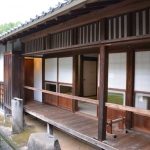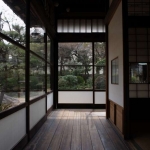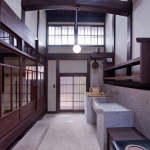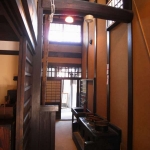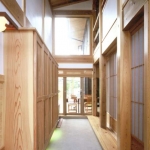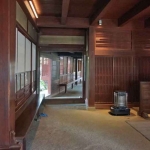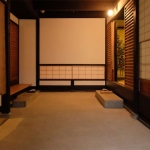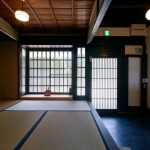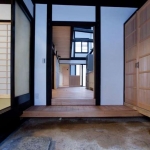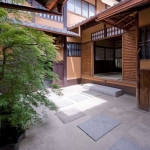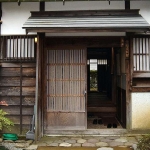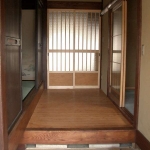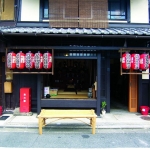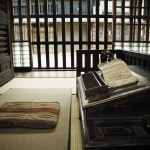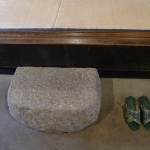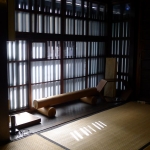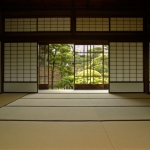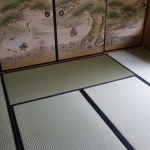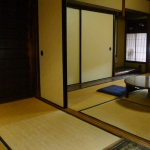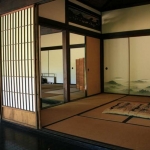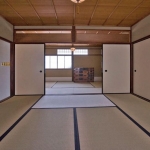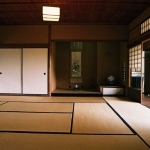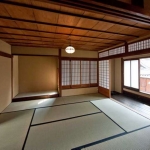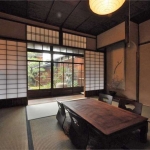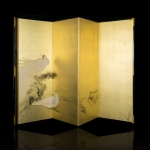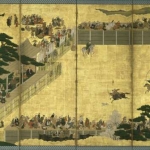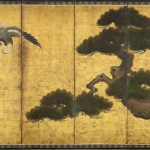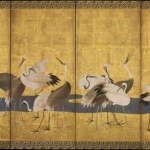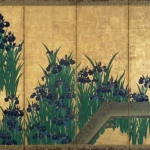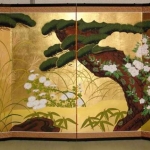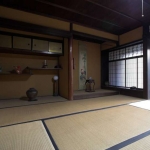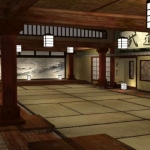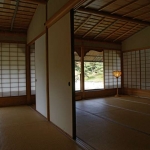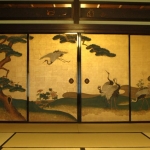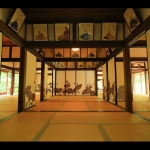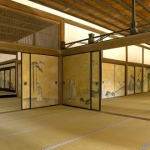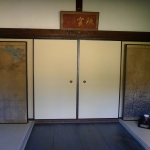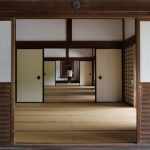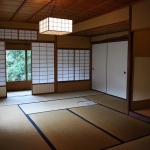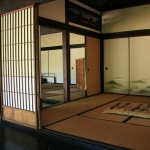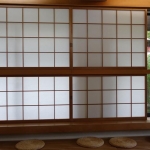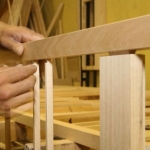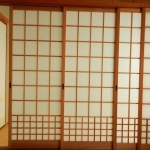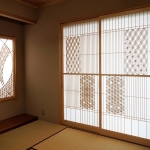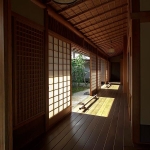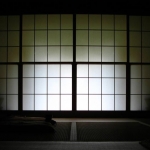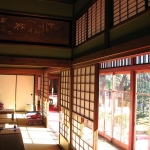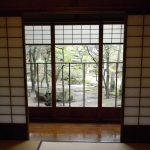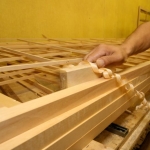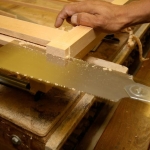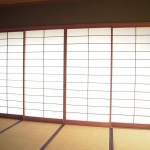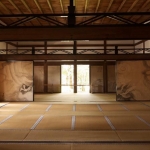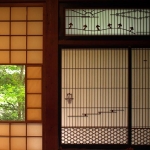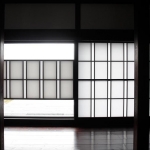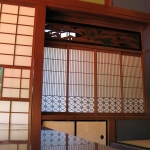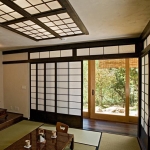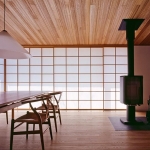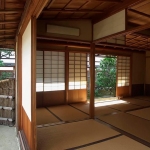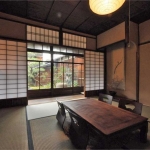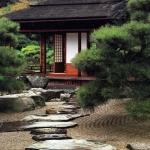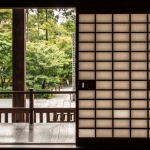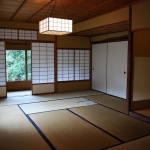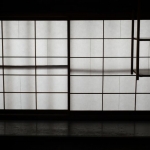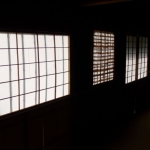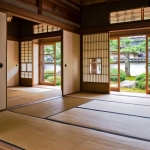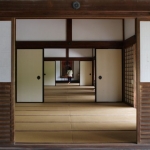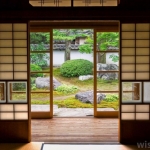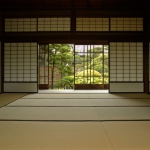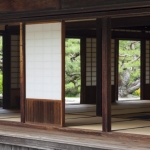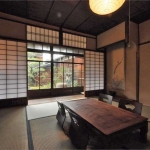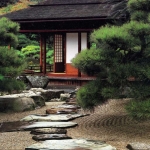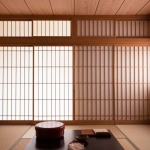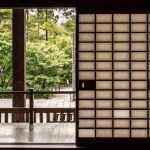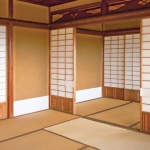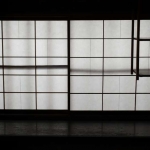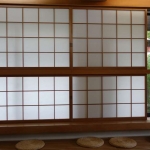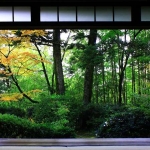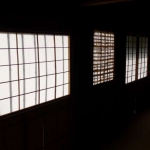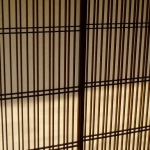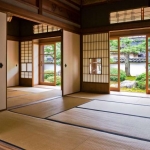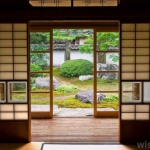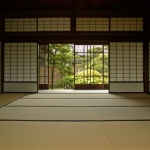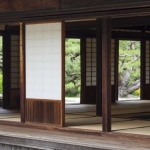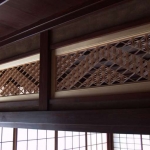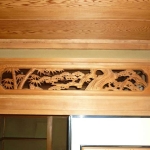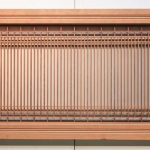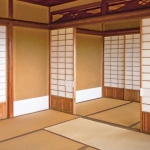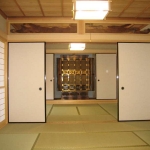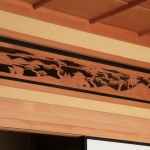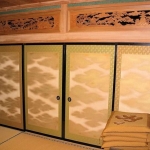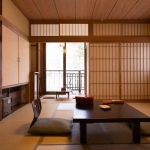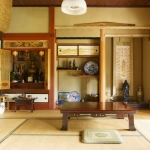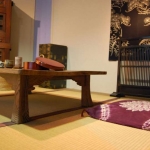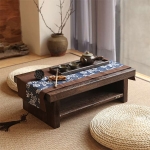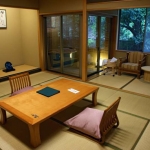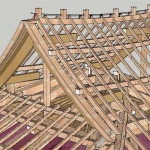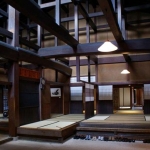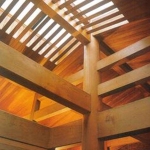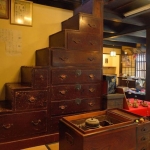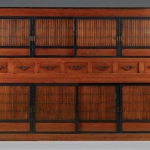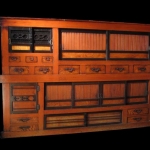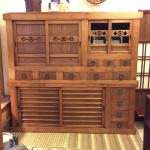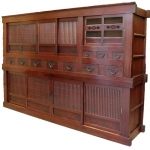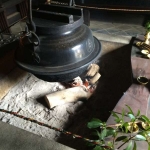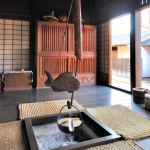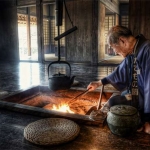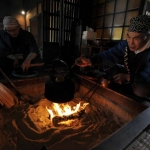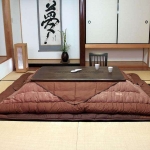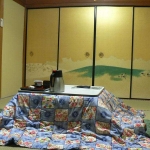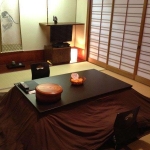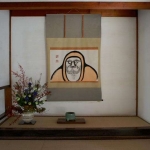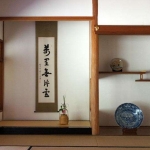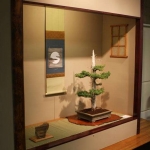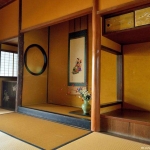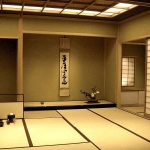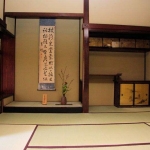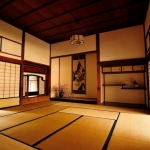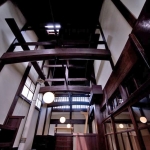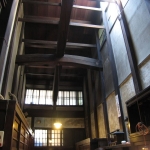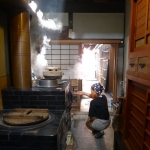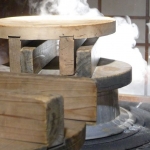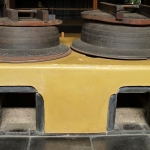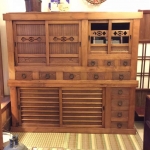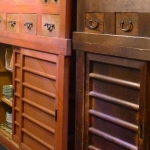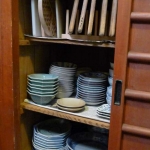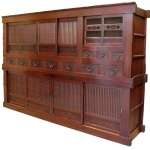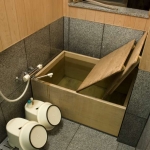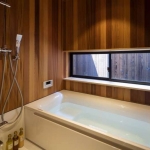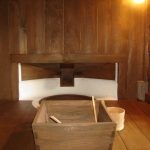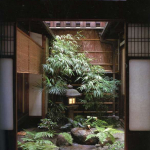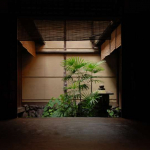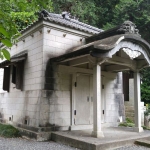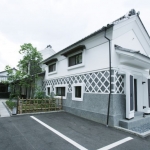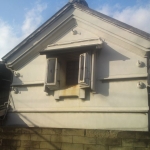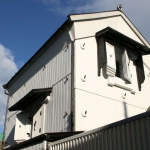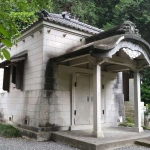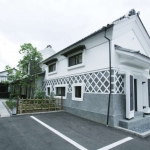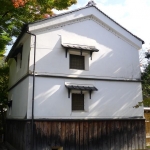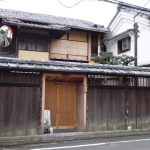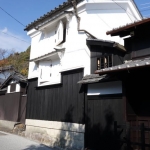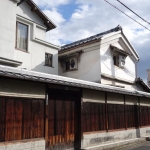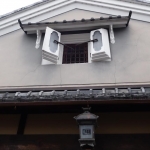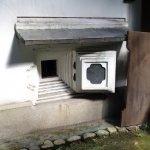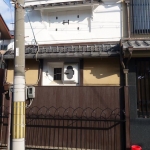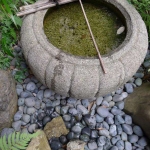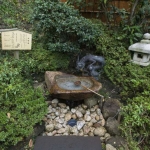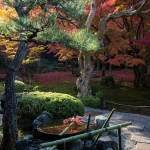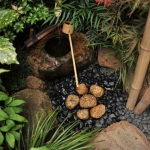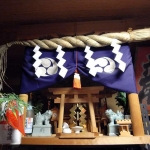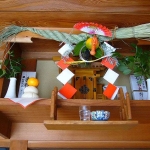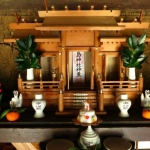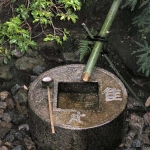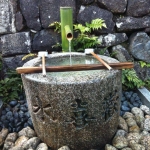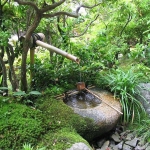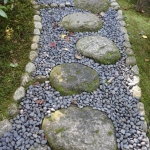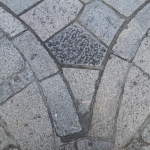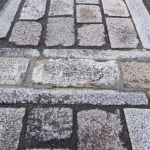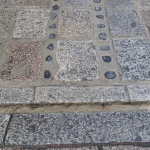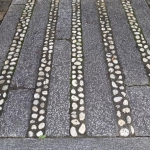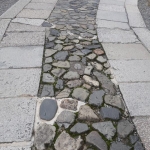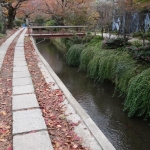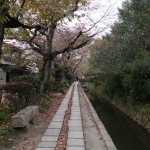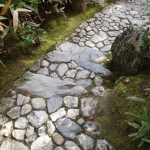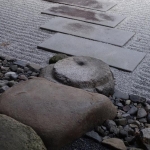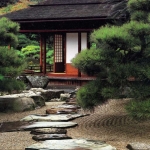Architectural Features
It looks like a cloud of smoke
But as I come closer
To the old house
In this ancient village
I see it is billowing willow.
–Rengetsu
Traditional Japanese houses have unique architectural and interior features that are considered an important part of Japan’s history and culture. These old features are often included in new homes because many people still find them charming. Family homes were historically viewed as temporary and were reconstructed approximately every 20 years. They were primarily made of wood and other natural materials such as paper, rice straw and clay. The following are a few common features of traditional Japanese homes. A review of these important architectural features will assist you in recognizing them as you travel around Kyoto. Click on thumbnails to view enlarged sample images.
Exterior of the Machiya:
|
Ichimonji One of the major characteristics of Kyo-machiya townhouses is that each eave is parallel to the street. This give the whole street scape a sense of unity. In order to emphasize this horizontal line, the lower eave edge of the roof tile is cut in a straight line. This is why the name ichimonji (the Chinese letter for “one”) has been given to this type of roof tile. |
|
|
|
|
|
Shouki-san The Demon Queller is a Zhong Kui doll made from roof clay and found on the eave above the main entrance. Zhong Kui was originally a Chinese legendary figure. According to the legend, the Emperor Xuanzong of Tang, China had a dream in which Zong Kui appeared, and later he recovered from a serious illness. Kyoto people decorate their houses with these dolls in hope of expelling epidemics such a maleria. |
|
|
|
|
|
Noren Traditional Japanese fabric dividers, hung between rooms, on walls, in doorways, or in windows. They usually have one or more vertical slits cut from the bottom to nearly the top of the fabric, allowing for easier passage or viewing. Exterior noren are traditionally used by shops and restaurants as a means of protection from sun, wind, and dust, and for display of shop name or logo. Interior noren are often used to separate dining areas from kitchen or other preparation areas, also serving to prevent smoke or smells from escaping. Sentō (commercial bathhouses) also place noren across their entrances, typically blue in color for men and red for women. They are also hung in the front entrance to a shop to signify that the establishment is open for business, and they are always taken down at the end of the business day. |
|
|
|
|
|
Mushiko-mado The majority of townhouses made before the Meiji period (until 1868) have mezzanines with low ceilings. A window with vertical lattices covered with clay or plaster is set onto the mezzanine facade for ventilation. The name mushiko (insect cage) is given to this type of window as then resemble insect cages. |
|
|
|
|
|
|
De-goshi In Kyoto, wooden lattices (koshi) are installed for two purposes: to allow light and air to pass through and at the same time to protect the privacy of the inhabitants. The forms of koshi lattices differ according to the profession of the house owner. For example, a fuya (wheat glutten shop) or a someya (dyer) have their own pattern of lattices. They are called de-goshi when they protrude into the street below the eave. |
|
|
|
|
|
Large Door (Oh-do) and Small Door (Kuguri-do) A small sliding door (kuguri-do) is set on a large sliding door (oh-do) in Kyo-machiya. For everyday use a small door is used, and the large door is used whenever it is neccessary for large items to be moved in and out. |
|
|
|
|
Inuyarai Or “dog barrier” are curved bamboo covers over a gutter in front of a house. It was used to keep everything at a distance from buildings that opened right on to the street. |
|
|
|
|
|
Battari-shogi A retractable bench that was installed in the front to be folded away when not in use. The original purpose was for displaying commodities in the daytime. At night it is put away. Sometimes it is used by the people to sit on and cool down in summer. |
|
|
|
|
|
|
Komayose Wooden railings that were used as a hitching post in front of some buildings. |
|
|
|
|
Koshimado Dark slotted windows that shielded residents form the eyes of passerby. |
|
|
|
|
|
|
Sudare Screens or blinds. They are sometimes called misu as well, particularly if they have a green fabric hem. Sudare are made of horizontal slats of decorative wood, bamboo, or other natural material woven together with simple string, colored yarn, or other decorative material to make nearly solid blinds. read more… |
|
|
|
|
Amado Storm shutters that are used to completely seal a home or apartment for security, privacy and safety. They are particularly important as protection from typhoons. Amado are a practical item that are either wooden planks or sheets of metal. They completely transform the aesthetics of a house. A home that looks open and inviting in the day surrounded by shoji screens may look more like a wooden shack at night surrounded by walls of wooden planks. |
|
|
|
|
|
Engawa An outer corridor that wraps around a Japanese house. These were traditionally used as a separator between delicate shoji and outer storm shutters. When the storm shutters are shut, engawa feel something like a secret passageway that circles a house and can be extremely narrow. In some cases, large houses have a wide engawa that resembles a wrap-around veranda when the storm shutters are open. |
|
|
|
|
Interior of the Machiya: |
|
|
|
Toriniwa A narrow earthen-floored passageway which penetrate from the front to the rear of kyo-machiya is generally referred to as toriniwa. A door in the middle divides the two parts; the front is called miseniwa. |
|
|
|
|
|
Genkan The main entrance to a house that has a lower level floor where you remove your shoes. This area is considered extremely dirty. People leave their shoes facing towards the door and take care not to step in the lower part of the floor in their socks. There’s usually a shoe closet directly beside the genkan. A spacious genkan is a popular feature of houses since that’s where guests are greeted. Wearing shoes into a home in Japan is considered a shocking breach of manners that’s akin to splitting on the floor. A genkan is the main entrance to a house that has a lower level floor where you remove your shoes. This area is considered extremely dirty. People leave their shoes facing towards the door and take care not to step in the lower part of the floor in their socks. There’s usually a shoe closet directly beside the genkan. A spacious genkan is a popular feature of houses since that’s where guests are greeted. Wearing shoes into a home in Japan is considered a shocking breach of manners that’s akin to splitting on the floor. |
|
|
|
|
Misenomas The shop room that is nearest the street where craftsmen could be seen working. |
|
|
|
|
|
|
Tatami For all buildings, a tatami of 3 x 6 feet became the architectural standard of measurement. Rooms may still be measured according to the number of mats they contain. Except for the toriniwas, all rooms were raised about two feet above ground level to provide ventilation during Kyoto’s humid summers. The tatami mats allow the floor to “breathe.” Entering one of these machiya, stepping up from the toriniwa to the raised tatami shop room, customers were invited to sit down to discuss business over a cup of tea. It is still possible to experience this. Tatami are mat floors traditionally made of rice straw. They are a standard size that varies by region. Tatami are so common in Japan that houses and apartments are often measured using the size of a tatami as a unit. They represent a traditional lifestyle that involves sitting and sleeping on the floor. Tatami have a soft, natural feel on your feet and have a pleasant smell when they’re new. They are associated with a wide range of manners and customs such as sitting seiza. |
|
|
|
|
Zashiki The heart of the house and used for entertaining, but was always changeable with the use of fusuma doors that served as walls. |
|
|
|
|
| Byobu https://en.wikipedia.org/wiki/By%C5%8Dbu | |
|
|
|
|
|
Shoin-zukuri A style of Japanese residential architecture used in the mansions of the military, temple guest halls, and Zen abbot’s quarters of the Azuchi-Momoyama (1568-1600) and Edo periods (1600-1868). It forms the basis of today’s traditional-style Japanese house. Characteristics of the shoin-zukuri development were the incorporation of square posts and floors completely covered with tatami.The style takes its name from the shoin, a term that originally meant a study and a place for lectures on the sūtra within a temple, but which later came to mean just a drawing room or study. Shoin is a type of audience hall in Japanese architecture that was developed during the Muromachi period. From this room came the name for the shoin-zukuri style. In a shoin-zukuri building, the shoin is the zashiki, a tatami-room dedicated to the reception of guests. |
|
|
|
|
Fusuma Sliding paper doors that act as room dividers and can be removed to adapt for various uses. These doors are replaced by reed screen in summer to help with ventilation or removed completely. Fusuma are sliding panels that act as doors and walls. They give Japanese homes many possibilities as rooms can be dynamically reconfigured. |
|
|
|
|
|
|
Shoji A door, window or room divider consisting of translucent paper over a frame of wood which holds together a lattice of wood or bamboo. While washi is the traditional paper, shōji may be made of paper made by modern manufacturing processes; plastic is also in use. Shōji doors are often designed to slide open, and thus conserve space that would be required by a swinging door. They are used in traditional houses as well as Western-style housing, especially in the washitsu (Japanese-style room). In modern construction, the shōji does not form the exterior surface of the building; it sits inside a sliding glass door or window. They are used for both interior and exterior walls. They help to give Japanese houses their character by allowing diffuse light and shadows through. In summer they are often removed completely, opening the house to the outside—a desirable arrangement in Japan because of the extreme humidity. The shoji is a feature of the shoin style, which first appeared in the Kamakura period (1192–1333). |
|
|
|
|
Ranwa Panels found above shoji or fusuma that are designed to let light into rooms. They are often ornate wooden carvings or shoji screens. |
|
|
|
|
|
Chabudai Tables with short legs that are used while sitting on the floor. They are most typically used on tatami floors but make appearances on harder floors too. It’s common for families to eat at a chabudai while sitting on zabuton. Zabuton are thin pillows that are used to sit on tatami floors. They are essentially the equivalent of a chair. At sumo matches, crowds are known to throw their zabuton into the ring to protest an unpopular outcome. |
|
|
|
|
|
Wagoya Japanese carpenters developed advanced joinery techniques and occasionally constructed large buildings without using any nails. Complex wooden joints tied with rope can be seen in the frames of old Japanese houses. Traditional frames, known as wagoya, have a post-and-lintel design. |
|
|
|
|
|
Tansu The traditional mobile storage cabinetry indigenous to Japan. Tansu was first recorded in the Genroku era of the Edo Period (1688–1704). The two characters, TAN and SU, appear to have initially represented objects with separate functions: the storage of food and the carrying of firewood. Since the radical for bamboo appears in each of these characters, it may be conjectured that wood was not as yet used. During the time period in which tansu gradually became a feature of Japanese culture and daily life, 1657–1923, both hard and softwoods were used by Tansuyas (tansu craftsmen), often in practical combination for a single chest. Woods commonly used in tansu included Keyaki (elm), Kuri (chestnut), Ezo matsu (pine), Sugi (cedar), Kiri (paulownia) and Hinoki (cypress).
|
|
|
|
|
|
|
Irori A traditional Japanese sunken hearth that is used both to cook food and heat a room. They consist of a stone lined square pit built into the center of a floor. A decorative adjustable hook called a jizaikagi hangs from the ceiling above the pit can be used to suspend a pot over the fire. Few modern homes include a irori and they are increasingly rare. Old restaurants in the Japanese countryside sometimes have one. Wherever they are found they are popular in winter. |
|
|
|
|
|
Kotatsu A low table with an built-in electric heater covered by a heavy futon blanket. People sit with their legs under kotatsu to relax, have a meal, study or watch television for hours on end. In many families, the kotatsu table is in high demand in winter. In most regions of Japan, houses aren’t centrally heated and rely on various forms of space heating. |
|
|
|
|
|
Tokonoma A built-in recessed space in a Japanese style reception room, in which items for artistic appreciation are displayed. In English, tokonoma is usually called alcove. The items usually displayed in a tokonoma are calligraphic or pictorial scrolls and an arrangement of flowers. Bonsai and okimono are also sometimes displayed there, although traditionally, bonsai were considered to be too dirty for such a highly respected place. The tokonoma and its contents are essential elements of traditional Japanese interior decoration. The word ‘toko’ literally means “floor” or “bed”; ‘ma‘ means “space” or “room.” Tokonoma are related to several rules of manners and etiquette. For example, it is considered extremely bad form to stand or sit in the tokonoma. A respected guest is seated close to the tokonoma with their back to it. This is a humble gesture that avoids showing off your prized art in the tokonoma to your guest. The tokonoma is kept mostly bare with a single piece of art or some combination of a painting and ikebana. |
|
|
|
|
|
Chigai-dana Shelves built into a wall, a feature of the shoin style of domestic architecture, which first appeared during the Kamakura period (1192–1333). What was previously a freestanding bookcase for scrolls and other objects became, with the chigai-dana, a built-in wall storage area, a companion bay to the tokonoma (alcove for the display of art objects), which is sometimes open and sometimes closed with sliding doors. The word chigai-dana (chigai, “different”; dana, “shelf”) suggests how the shelves are hung: two or more are always arranged in a staggered manner, usually with a continuous shelf above. |
|
|
|
|
Nama Noren A rope curtain that separates the kitchen from the shop room. |
|
|
|
|
| Exposed Beams | |
|
|
|
|
Kamodo In the kitchen, you find a well and a large clay oven, the Kamodo, and its rice caldron. Above it you will always find a small shrine to the god of fire. Japanese culture was founded in the deeply felt tradition of paying respect to the kami, or gods, who protect everything from ovens to rice fields. Kyoto was destroyed by fire many time, so no household would be without a symbolic bucket of water, a reminder that one must always take care with fire. |
|
|
|
|
|
Mizuya Literally means ‘water house’ in Japanese, and is a type of wooden cabinet made to house tableware. It is a long wooden cabinet that lined one wall of every kitchen. It was constructed in parts that made for easier removal in case of fire. |
|
|
|
|
|
|
Ofuro The Japanese word for bath. In old Japan, homes didn’t have baths and people visited communal baths known as sento each evening. By the Meiji-era, baths started to become a more common feature in houses. Japanese baths are usually in a separate room from the toilet. They often have an adjoining dressing room. The baths themselves tend to be deep but short. It’s customary to completely clean yourself before entering the bath. A separate shower area sits beside the bath for this purpose. The Japanese see bathing as a leisure activity and tend to take long baths. Baths made of wood are a luxury feature of some homes and ryokan. The earliest home baths were essentially wooden drums and variations of this style remain popular. |
|
|
|
|
Tsubo niwa A small space about 6 feet square is often found deep in the interior of the home and used to create small gardens. More prosperous merchants would have more than one interior garden and often polished wood verandahs ran along their edges. |
|
|
|
|
|
|
Kura Were often found in the main garden at the back of a prosperous merchant’s home was the the kura or family storehouse with its thick walls and heavy doors. |
|
|
|
|
|
Suikinkutsu Literally, “water koto cave” is a type of Japanese garden ornament and music device. It consists of an upside down buried pot with a hole at the top. Water drips through the hole at the top onto a small pool of water inside of the pot, creating a pleasant splashing sound that rings inside of the pot similar to a bell or a Japanese zither called koto. It is usually built next to a traditional Japanese stone basin called chōzubachi, part of a tsukubai for washing hands before the Japanese tea ceremony. |
|
|
|
|
|
Kamidana Small Shinto Shrines that are used to remember departed loved ones in Japanese homes. It’s common to light incense at a kamidana each morning. They are typically surrounded by lucky items and offerings of food or beverages. Another element of nature interspersed within kyo-machiya are the different animist gods found in various parts of a traditional house. The most famous house god is Hotei, traditionally found in front of the hearth of every kitchen. There are gods, for example, for a house’s central pillar, main beam, front door, and even the toilet. There are also gods protecting the butsudan, the family altar, the tokonoma, the area of greatest respect for visitors, and the kimon, a potential entranceway for bad spirits, usually located in the north-east and south-west corners of a kyo-machiya. In fact, on the scale of Kyoto as a whole, Mount Hiei, in the north-east corner of the mountain ranges that surround Kyoto acts as the kimon for the whole city. |
|
|
|
|
|
Tsukubai A washbasin provided at the entrance to holy places for visitors to purify themselves by the ritual washing of hands and rinsing of the mouth. This type of ritual cleansing is the custom for guests attending a tea ceremony or visiting the grounds of a Buddhist temple. The name originates from the verb tsukubau, meaning “to bow down”, an act of humility. Tsukubai are usually of stone, and are often provided with a small scoop, laid across the top, ready for use. A supply of water is provided via a bamboo pipe called a kakei. |
|
|
|
|
Pathways Stepping stones are called “tobi-ishi“ (飛石) in Japanese. The literal translation is “Flying stones” or “Skipping stones”. Walking on a stepping stone path requires much more attention than walking on a paved surface – the visitor has to make tiny jumps to get from one stone to another. This influences the way a visitor experiences the garden. While it is possible for two or more people to comfortably walk next to each other on neatly laid out paths and maybe have a conversation, a stepping stone path forces the visitors to go in line, one after the other. This is one reason why tea gardens often have stepping stones. While walking down the path to the tea house, the guests have time to “arrive” in the garden, leave their everyday life behind and prepare mentally for the tea ceremony to come. Tea master Sen no Rikyu (千利休) is said to have introduced the tobi-ishi path – he did not like that sandals and shoes became dirty when walking on the bare soil. He also recommended that the stepping stones are 6cm higher than the ground. Other tea masters after him preferred them to be 5cm (Furuta Oribe) and 3cm (Kobori Enshu). |
|
Other information:
https://en.wikipedia.org/wiki/Machiya http://www.pref.kyoto.jp/visitkyoto/en/theme/sites/traditional_buil/


